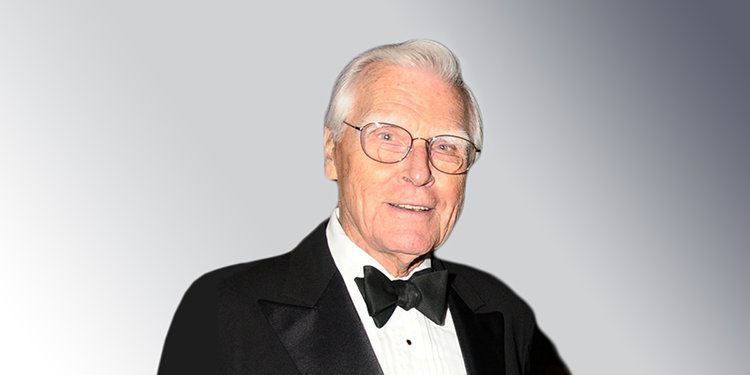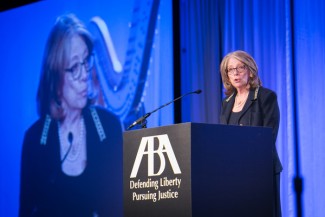A lawyer looks at 100

After his military service in WWII, Alexander Forger became a trusts and estates lawyer for luminaries like Jaqueline Kennedy Onassis and Katharine Hepburn. (Photo courtesy of Alexander Forger.)
It’s rare to meet a 100-year-old lawyer. It’s perhaps even rarer to sit with that lawyer and listen as they reflect on their life and career.
Alexander Forger, who joined the centenarian club in February, recently gave the ABA Journal that opportunity.
The New York native spoke about serving as a U.S. Army machine-gunner in World War II, during which he earned a Bronze Star, and pursuing his law degree at Yale Law School. He shared his experiences of becoming a renowned trusts and estates lawyer and chairman of Milbank in New York City and then president of the Legal Services Corp., where he staunchly advocated for access to justice. Under Forger’s leadership, Milbank became the first law firm in New York City to offer same-sex partner benefits in 1992. He also worked on several gay rights and HIV anti-discrimination initiatives.
Forger, who was president the New York State Bar Association and president and chair of the Legal Aid Society, also hoped during our conversation to convey one valuable message: Being a lawyer has been a privilege, offering him many opportunities to be useful and enjoy a satisfying life.
The interview, which has been edited for clarity and length, is below.
Starting at the beginning, why did you decide to be a lawyer?
Well, there wasn’t a definite reason. My father had always wanted to be a lawyer and kept telling me I should go to law school. I had a couple of courses in college on constitutional law, which intrigued me. Then I came back from the war, got married, and so, what am I going to do now? I had the GI Bill and decided, “This is the time to go to law school.” The GI Bill paid tuition and $75 a month. Easy decision.
I could see that! Going back to your time in the Army, what was that experience like?
I have thought of it as a critical, extremely important experience in my evolution. Having been from a middle-income, white community and going to Princeton, which was filled with social stigma and prep school guys, I had a difficult time integrating in the school.
I went into the Army and spent a year and a half in the U.S., mostly in the South—Alabama, Mississippi and Kentucky. It was the first time I saw legal discrimination: fountains for whites and Blacks, and if you’re on a train, it was whites only here. I remember being in Mississippi, and Black people getting off the sidewalk to let us walk by.
Then I got into Europe and into combat with a machine-gun squad of seven fellows of different backgrounds, different religions, different education. It became crystal clear to me that what mattered was not all those differences but rather who they really were. Were they good companions, and would they help me if I was in trouble? And would I help them?
I returned to Princeton and tried to implement that feeling. As Martin Luther King Jr. said, the content of the character is what matters, not the color of the skin or any other identifiable difference. Among other things in wartime, that’s what I learned. I was in my early 20s, so I carried that through the rest of my life.
You joined Milbank in 1950 and became a trusts and estates lawyer. What were some of the highlights of your practice?
First off, I’ll say there were 75 lawyers, two women, for which apologies were given. Because during wartime, they had to hire a couple of women. Heavens, they weren’t partners. In my time at the firm—it was 40-plus years—it turned from WASP, White Anglo-Saxon Protestants, male, into a diverse community. We had women partners, Black partners, homosexual partners. It became a different kind of institution.
There was a rotation in which you try different areas, and I found trusts and estates to be more interesting. I found it enjoyable dealing with individuals with their own personalities and personal issues. Milbank at that time was pretty much known as the Rockefeller law firm. So, it was Rockefeller, Rockefeller University, Rockefeller Center, Rockefeller Resorts.
I had some dealings with the Rockefeller family. But what turned out to be my principals for about 20 years, I represented Jacqueline Kennedy and her estate. I represented Mrs. Paul Mellon—Rachel Mellon—for about 25 or more years through the administration of her estate. My one movie star was Katharine Hepburn.
You retired after four decades in private practice, but you didn’t stop working. What came next for you?
During all that, I was also engaged in volunteer work, pro bono. I started working on briefs for criminal issues for people who couldn’t afford counsel. That was before Gideon v. Wainwright came along. But then I spent 20 to 25 years with the Legal Aid Society, becoming its chair for a great number of years and managed to attract volunteers into the program. I enjoyed very much trying to improve access to justice for poor people.
When [Legal Services Corp.] was created, legal aid lawyers could do everything for the poor that a lawyer could do for a wealthy client. Well, that didn’t last very long because they also eliminated class actions. They eliminated any legislative work or lobbying. They eliminated certain people, some of the migrants and other disfavored people, that we could handle. We couldn’t touch any welfare activity. They eliminated training centers we had for lawyers coming in and working on these core problems. They did their very best to make us less efficient, less essential.
How did you persevere through those challenges? How did you continue to help people who needed legal services get them?
Certainly, it increased the need for volunteerism. In New York and elsewhere, there was a major effort to increase the activity of lawyers representing [low-income clients]. What we’ve been trying to do since then—I’ve been on New York’s Permanent Access to Justice Commission until a few years ago—is address problems of poverty. If you can reduce poverty, that’s a good result. And also, sensitize the bar to more of this activity.
I have been carrying the spear for mandatory pro bono, and the notion that we who have the privilege of a monopoly on the practice of law should have an obligation to see that justice is available, even to those who cannot afford to pay us. When I was president of the New York State Bar, I offered that in 1980-1981. As a resolution, it was defeated 122-2. But with the New York City Bar and others still seeking to promote that, some progress has been made.
One group in particular you have assisted throughout your career is the LGBTQ community. Why is this community important to you?
I have a son who is gay, and I have witnessed firsthand the discrimination he faced growing up and in school and employment. But I also resented what I heard in Washington: “We don’t like gay people. God did not create gay people. They’re bad.” People who are gay, who have great character and attitudes and morality, who are ordinary, decent people, why is it that we need to dislike them?
The one thing I managed in practice was to get [trusts and estates] groups from the major firms early in the AIDS epidemic to offer assistance in hospitals to those who were desperately ill with AIDS. I even got clearance from the Catholic diocese to do that in a Catholic church. It was simple. They’re ordinary folks, and maybe they want a power of attorney, maybe they want a will. There is something we can do to help them. That goes, again, for all people with differences.
In 2011, the ABA’s HIV/AIDS Impact Project named an award after you, to recognize your leadership. What did that mean to you?
I can recall being at one event and somebody asking me, when did I come out? I said, “No, no. I am out in support of what you do.” But I’ve had some people who have said they have benefited from that point of view, who themselves are gay, who have been able to be respected. And I think that’s something we all can do. You know, help each other.
What are some other ways you’ve been involved in the ABA?
I remember one big debate [in the House of Delegates] relating to women being excluded from these private clubs in New York. The first day I became chairman of the firm, I ended the firm’s weekly partnership meeting in one of these clubs. We had a woman partner, so we left. But in the ABA, we were having this dialogue of, “Should we take a position on opening these clubs to women?” It was a very strong debate, and we lost. We were not able to take a position.
 Roberta Cooper Ramo, shown here accepting the ABA Medal in 2015, was the first woman to be president of the American Bar Association. (Photo by ©Kathy Anderson)
Roberta Cooper Ramo, shown here accepting the ABA Medal in 2015, was the first woman to be president of the American Bar Association. (Photo by ©Kathy Anderson)Another big issue was Roberta Ramo. I was working in her campaign to become president. I think there was something like 50 votes, and she lost. But she tried once again, and by golly, she became the first woman president of the ABA. And she was there at our 20th anniversary of Legal Services Corp. Roberta was a big help to us.
I was chair of the Commission on Law and Aging. I had the privilege of being, on the basis of that credential, selected in the Brooke Astor case as an expert witness. I worked with young people, and I worked with the American Bar Foundation. It was a good experience.
We’ve talked about a lot today, and this might be a hard last question. When you’re thinking about your very long career, what is one of the things you’re most proud of?
I don’t know what was most important: law school, Rockefeller University, Legal Services, certainly, were all important.
But from the point of view of the consequence and effect on people, generally, I hope I served clients well. And from the point of view of practice and life, generally, recognizing people for who they are and what they are, not what they look like.



